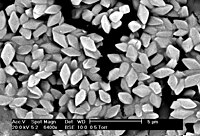
Photo from wikipedia
Simple Summary Immune responses of Lepidopteran pests to Bacillus thuringiensis (Bt) or Bt toxins, including pattern recognition proteins, antimicrobial peptides (AMPs) and their synthetic signaling pathways, the prophenoloxidase system, reactive… Click to show full abstract
Simple Summary Immune responses of Lepidopteran pests to Bacillus thuringiensis (Bt) or Bt toxins, including pattern recognition proteins, antimicrobial peptides (AMPs) and their synthetic signaling pathways, the prophenoloxidase system, reactive oxygen species (ROS) generation, nodulation, encapsulation, phagocytosis, cell-free aggregates, contribute to the evolution of insect resistance to Bt. Targeting the insect immune response and resistance to Bt or Bt toxins may help to improve insecticidal activity and manage insect resistance. Abstract Bacillus thuringiensis (Bt) is the safest, economically successful entomopathogen to date. It is extensively produced in transgenic crops or used in spray formulations to control Lepidopteran pests. The most serious threat to the sustainable usage of Bt is insect resistance. The resistance mechanisms to Bt toxins depend not only on alterations in insect receptors, but also on the enhancement of insect immune responses. In this work, we review the current knowledge of the immune response and resistance of insects to Bt formulations and Bt proteins, mainly in Lepidopteran pests. We discuss the pattern recognition proteins for recognizing Bt, antimicrobial peptides (AMPs) and their synthetic signaling pathways, the prophenoloxidase system, reactive oxygen species (ROS) generation, nodulation, encapsulation, phagocytosis, and cell-free aggregates, which are involved in immune response reactions or resistance to Bt. This review also analyzes immune priming, which contributes to the evolution of insect resistance to Bt, and puts forward strategies to improve the insecticidal activity of Bt formulations and manage insect resistance, targeting the insect immune responses and resistance.
Journal Title: Insects
Year Published: 2023
Link to full text (if available)
Share on Social Media: Sign Up to like & get
recommendations!